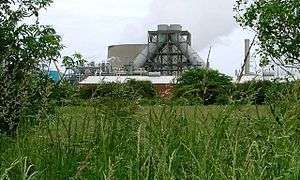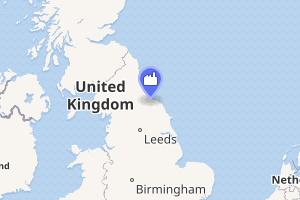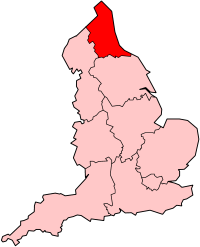Teesside power station
Teesside Power Station is a former gas-fired power station, in Redcar & Cleveland, England. Situated near the Wilton chemical complex, the station had combined cycle gas turbines (CCGTs) and open cycle gas turbines (OCGTs), however in 2011 the operation of the CCGT part of the station was suspended, and in 2013 the owners announced its closure and plans to demolish it. Prior to the suspension, the station had a generating capacity of 1875 megawatts (MW), making it the largest of any CCGT power station in Europe. The station could meet almost 3% of the electricity demand for England, Wales and Scotland. Opened in 1993, the station was initially operated by Enron but moved into the hands of PX Ltd after the Enron scandal of 2001, before being bought by Gaz de France and Suez in 2008. The station also worked as a cogeneration plant, providing steam for the Wilton complex.
| Teesside power station | |
|---|---|
 Teesside Power Station Viewed from the west in June 2006 | |

| |
| Country | England |
| Location | Wilton, Redcar & Cleveland, North Yorkshire |
| Coordinates | 54.576838°N 1.120417°W |
| Status | Decommissioned |
| Commission date | 1993 |
| Decommission date | 2015 |
| Owner(s) | Enron (1993-2002) PX Ltd (2002-2008) GDF Suez (2008-2015) |
| Thermal power station | |
| Primary fuel | Natural gas |
| Cooling source | Fresh |
| Power generation | |
| Nameplate capacity | 1875 MW |
| External links | |
| Commons | Related media on Commons |
History
The power station was constructed on a 23-acre (93,000 m2) site at the Wilton chemical complex near Middlesbrough in north east England. Construction of the station began in December 1990 and took twenty nine months to complete.[1] The main contracted construction work was undertaken by Westinghouse and Wimpey, employing a largely local workforce of 3,000.[1][2] The station was commissioned in April 1993.[1] The station was originally owned and operated by US energy company Enron.[3]
A visitor centre at the power station was opened by MP Mo Mowlam on 6 November 1998.[4]
During maintenance closure in August 2001, an explosion in one of the power station's transformers killed three workers and injured another man.[2][5]
After Enron's bankruptcy in 2002, the power station was sold to a management buyout. It was owned by Teesside Power Limited (TPL) and operated on behalf of its owners by PX Limited.
In October 2007 it was put up for sale by its private equity owners Cargill and Goldman Sachs, valued between £200 million and £300 million.[3] On 25 February 2008 the station was acquired jointly by Gaz de France and Suez.[5][6]
Plans for a £500 million upgrade of the station were granted planning permission in 2008.[5] This upgrade would consist of replacing the existing generating equipment with four 300 MW gas turbines and two 340 MW steam turbines. This would retain the power station's current capacity.[7] However, with no work having begun by 2010, a five-year extension to the permission was granted in April 2010.[5]
Following a merger between GDF and International Power in 2010, the ownership of the site was shifted to the latter company.[5]
On 1 April 2011, GDF surrendered 1,830 MW of transmission entry capacity (TEC) of the station and ceased operations of the CCGT element of the plant leaving the Open Cycle gas turbine as the only available machine, leaving the station with an operating capacity of 45 MW. This was due to the low cost of energy imports and a weak market in the UK, resulting in a need to save on operating costs. It is unknown how long the power station will be out of operation for and around 100 workers may lose their jobs due to the mothballing. International Power's lack of clarity over the workers' jobs has been condemned by unions, with Unite the Union North East regional officer Bob Bolam stating "The company might say they will keep the plant on standby but workers can’t hang around waiting for an upturn". It is yet to be decided whether the mothballing will effectively shelve the planned upgrade of the power station.[5] MP for Middlesbrough South and East Cleveland Tom Blenkinsop also criticised the move, calling on Secretary of State for Energy and Climate Change Chris Huhne to "see to it that the [owners] ... are not allowed to pull the plug on this plant at this time." in relation to forthcoming end of the lives of UK coal and nuclear plants.[8]
The owners, GDF Suez, announced in 2013, their intention to permanently close and demolish the plant.[9] This was completed by early 2015.[10]
In 2018, the local authority was told it had pay £2.6m to GDF Suez to due to a backdated re-evaluation of business rates for the site.[11]
Specifications
With a total generating capacity of 1,875 MW, the station had the largest generating capacity of any CCGT power station in Europe, although it had been the largest in the world at the time of opening.[2] It was able to generate enough electricity to provide 3% of England, Wales and Scotland's combined power needs. The electricity was produced by a number of generators. These were: eight 152 MW Mitsubishi Heavy Industries Westinghouse 701DA gas turbines, each fitted with a Nooter Eriksen heat recovery steam generator, with supplementary firing; two 305 MW Mitsubishi Westinghouse steam turbines; and a single 43 MW LM6000 General Electric black start gas turbine. These generators were fuelled by natural gas, propane and naphtha.[1][2] As of 1 April 2011, the station was only generating 45 MW after a partial mothballing of the station.[5]
The gas fuel used in the power station was provided from a nearby gas processing plant.[12] It was also connected to UK national gas transmission grid. Water used in the station's steam cycle was cooled by three cooling towers. Electricity generated at the station was distributed to the National Grid via 275-kilovolt (kV) substations built by ABB.[2]
As well as generating electricity, the station also produced heat in the form of 800 tonnes (880 tons) of process steam per hour for the adjacent Wilton chemical complex, and 2,000 tonnes (2,200 tons) of gas liquids per day, in the form of propane, butane and hydrocarbons.[2]
References
- "Teesside Power Station". GDF Suez. Retrieved 17 May 2011.
- "Teesside Power Station". engineering-timelines.com. Retrieved 17 May 2011.
- Harrington, Ben (14 October 2007). "Teesside power plant is put on the block". Telegraph. London. Retrieved 7 March 2008.
- "Teesside Power Station". Teesside Power. Retrieved 9 August 2008.
- Davison, Jez (30 March 2011). "Around 100 jobs in jeopardy at Teesside Power Station". Evening Gazette. Retrieved 17 May 2011.
- "Suez and Gaz De France jointly acquire Europe's largest CCGT plant". Power Engineering International. 25 February 2008. Retrieved 25 February 2008.
- "Power station upgrade". GDF Suez. 2008. Retrieved 17 May 2011.
- Blenkinsop, Tom (30 March 2011). "Teesside Power Station mothballing threat "clear sign that Government are failing to construct a proper energy strategy"". www.tomblenkinsop.com. Retrieved 17 May 2011.
- http://www.powerengineeringint.com/articles/2013/10/gdf-suez-announces-demolition-of-1875-mw-plant.html
- Robson, Dave (16 December 2014). "Teesside Power Station at Wilton will soon be no more as demolition continues apace". Gazette Live. Retrieved 24 April 2018.
- Cain, James (25 July 2018). "Teesside council told to repay millions of pounds in taxes - which it never even received". Gazette Live. Retrieved 18 September 2019.
- "Aker Kvaerner Secures Contract at Teesside Power Station". contractors unlimited. 15 March 2005. Retrieved 8 May 2010.
